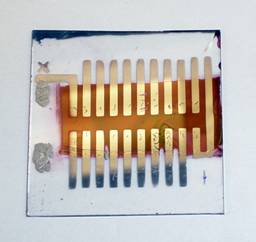

47107-G10
Nanocomposite of Infrared Quantum Dots and Conducting Polymers: Possible Multiple Exciton Dissociation
Narrative of progress-PRF grant 47107-G10
Objectives: The goal of the first grant year (07-08) was to study exciton dissociation process in pure, untreated lead chalcogenide quantum dots (QDs): how photogenerated carriers are evolved and how to characterize them.
Status of effort: The first grant year has seen our multi-tier efforts:
1). Establishment of the technique for studying exciton dissociation
The time this grant arrived, I have just finished installations of major equipments (optical setup and thin film device fabrication apparatus) in my lab. The first three months (Sept. ~Dec. 2007) were mainly contributed in establishing the major technique employed for the above objectives: the continuous wave (cw)-photoinduced absorption spectroscopy.
2). Secure of the sources of lead chalcogenide quantum dots (QDs)
Evident
Technologies, Inc. is the sole commercial supplier for lead sulfide (PbS) quantum dots used in this project. They require a
Material Transfer Agreement to be initiated between Evident and our institution
( 3) development of a spectroscopic measure for photoinduced
charge transfer
We
have discovered a below-gap state in pure PbS QDs that has confinement
dependence, and potentially can be used as an indicator to monitor photoinduced
charge transfer process between the QDs and polymers [1]. This
spectroscopic technique will guide the development of high efficiency hybrid
QD/polymer solar cells, which is the ultimate goal of this two-year project.
4).
Training of a graduate student on thin film solar cell fabrication
A
graduate student (Jason Lewis) has been trained on how to fabricate thin film solar
cells. He has been trained in Nanomanufacturing
Research Center (NNRC) at USF on photolithography, photomask-fabrication,
shadow mask design and fabrication and thin film nanotechnology. He was also
trained on how to operate our device fabrication facilities and characterize
solar cells. His first paper was submitted to Journal of Renewable and
Sustainable Energy one month ago[2].
Fig.1. Organic solar array based on P3HT/PCBM with 20-minature
cells in series for power supply in MEMS device [2]. Accomplishments/New
findings: This
year's research resulted in two high-profile journal publications [1,3] . Two more papers were submitted:
1). Interactions/Transitions: 1) Participation/presentations at meetings, conferences:
Team members participated at APS
2008 March Meeting ( I also attended an Army Research
Office conference in 2) Collaboration/consultation:
Our lab has built up a numbers of inter-institutional
collaborations with Dr. Sun's research group in Technical
impact: The results we have obtained in the first year is of paramount
importance for the continuous research effort on possible multiple exciton
dissociation in hybrid solar cells, which is ongoing right now. Our findings
about photoinduced charge transfer will help understand the essential process
of exciton dissociation and give us a guideline to achieve high efficiency of
the third generation solar cells, which has immediate impact on the
cost-effective utilization of renewable energy.
Broader
impact: I am very grateful the ACS-PRF grant I
received. Not only has it been the major supporting fund for my beginning
years, it has been a tremendous help for my potential grants from other Federal
agencies such as NSF, DOE, ARO and DARPA. It enables the sustainability for my
regular research activities, my participation in professional development
workshops, and my attendance of scientific conferences. And more important, it
has covered partial support for my graduate students. It serves as a milestone
in my career development, as well as a great contribution to USF's educational programs.
